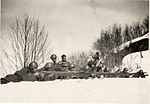Portal:Elezia/Features: Difference between revisions
No edit summary |
No edit summary |
||
| Line 1: | Line 1: | ||
<div style="float:left;margin:0.5em 0.9em 0.4em 0;">[[File: | <div style="float:left;margin:0.5em 0.9em 0.4em 0;">[[File:Greek_Army_during_Primavera_Offensive_Klisura_March_1941.JPG|150px]]</div> | ||
''' | The '''Fajatziak conflict''' ({{wp|Basque language|Ibarmentudiak}}: ''Fajatziak gatazka'') was an uprising in the northern Ibarmentudiak province of Fajatziak, in the Handikogoiordoki Confederal state. The uprising was fought as a guerilla conflict in early 1937, but escalated into a stagnant war from mid 1937 onwards, with the summer of 1939 seeing the heaviest fighting. The Ibarmentudiak Confederal government fought against the Fajatziak Social Liberation Front (''Fajatziak Gizarte Askapenerako Frontea, FGAF''), later joined by the Fajatziak Republic. The conflict is often considered one of the preceding conflicts to the later Ibarmentudiak Civil Conflict, a wider Guerilla war actively fought between 1984 and 2004, which is still being fought in rural Ibarmentudia in the modern era. The province of Fajatziak, before being part of the Confederal State of Handikogoiordoki and eventually Ibarmentudia was an independent Ibarmentudiak-speaking Country, and for the longest time had a separate national identity from the rest of the Ibarmentudiak-speaking world. As it was for the most part separated from the rest of Ibarmentudia by the Goimendi mountains and the Logrotxera river, it was one of the few Ibarmentudiak-speaking states which were free of being heavily influenced by the royal House of Aguirregoitiafelipena. However, during the 1819-1853 Alboziradia-based Ibarmentudiak Confederacy, Fajatziak lost its independence after a short war in 1849. During this time, Ibarmentudia was trying to unify the Ibarmentudiak-speaking countries of Parenthia, and despite the fact that it succeeded in its goal, Fajatziak kept its separate national identity. Eventually, the Confederacy fought a war against multiple foreign nations, and the democratic institutions were replaced by the Royal House of Saenz of Almagrian origin, which is still the ruling royal house of Ibarmentudia to this day. ('''[[Fajatziak Conflict|See more...]]''') | ||
('''[[ | |||
<div align="right"> | <div align="right"> | ||
'''<span class="plainlinks"> [https://iiwiki.us/mediawiki/index.php?title=Portal_talk:Elezia/Article&action=edit Suggest an Article] or or [https://iiwiki.us/wiki/Category:Elezia_Featured_Articles See Previous Features]</span>'''</div><noinclude> | '''<span class="plainlinks"> [https://iiwiki.us/mediawiki/index.php?title=Portal_talk:Elezia/Article&action=edit Suggest an Article] or or [https://iiwiki.us/wiki/Category:Elezia_Featured_Articles See Previous Features]</span>'''</div><noinclude> | ||
Latest revision as of 19:15, 2 July 2023
The Fajatziak conflict (Ibarmentudiak: Fajatziak gatazka) was an uprising in the northern Ibarmentudiak province of Fajatziak, in the Handikogoiordoki Confederal state. The uprising was fought as a guerilla conflict in early 1937, but escalated into a stagnant war from mid 1937 onwards, with the summer of 1939 seeing the heaviest fighting. The Ibarmentudiak Confederal government fought against the Fajatziak Social Liberation Front (Fajatziak Gizarte Askapenerako Frontea, FGAF), later joined by the Fajatziak Republic. The conflict is often considered one of the preceding conflicts to the later Ibarmentudiak Civil Conflict, a wider Guerilla war actively fought between 1984 and 2004, which is still being fought in rural Ibarmentudia in the modern era. The province of Fajatziak, before being part of the Confederal State of Handikogoiordoki and eventually Ibarmentudia was an independent Ibarmentudiak-speaking Country, and for the longest time had a separate national identity from the rest of the Ibarmentudiak-speaking world. As it was for the most part separated from the rest of Ibarmentudia by the Goimendi mountains and the Logrotxera river, it was one of the few Ibarmentudiak-speaking states which were free of being heavily influenced by the royal House of Aguirregoitiafelipena. However, during the 1819-1853 Alboziradia-based Ibarmentudiak Confederacy, Fajatziak lost its independence after a short war in 1849. During this time, Ibarmentudia was trying to unify the Ibarmentudiak-speaking countries of Parenthia, and despite the fact that it succeeded in its goal, Fajatziak kept its separate national identity. Eventually, the Confederacy fought a war against multiple foreign nations, and the democratic institutions were replaced by the Royal House of Saenz of Almagrian origin, which is still the ruling royal house of Ibarmentudia to this day. (See more...)
